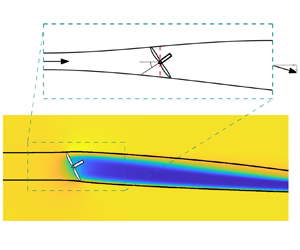Article contents
Modelling the induction, thrust and power of a yaw-misaligned actuator disk
Published online by Cambridge University Press: 16 March 2023
Abstract

Collective wind farm flow control, where wind turbines are operated in an individually suboptimal strategy to benefit the aggregate farm, has demonstrated potential to reduce wake interactions and increase farm energy production. However, existing wake models used for flow control often estimate the thrust and power of yaw-misaligned turbines using simplified empirical expressions that require expensive calibration data and do not extrapolate accurately between turbine models. The thrust, wake velocity deficit, wake deflection and power of a yawed wind turbine depend on its induced velocity. Here, we extend classical one-dimensional momentum theory to model the induction of a yaw-misaligned actuator disk. Analytical expressions for the induction, thrust, initial wake velocities and power are developed as a function of the yaw angle ( $\gamma$) and thrust coefficient. The analytical model is validated against large eddy simulations of a yawed actuator disk. Because the induction depends on the yaw and thrust coefficient, the power generated by a yawed actuator disk will always be greater than a
$\gamma$) and thrust coefficient. The analytical model is validated against large eddy simulations of a yawed actuator disk. Because the induction depends on the yaw and thrust coefficient, the power generated by a yawed actuator disk will always be greater than a  $\cos ^3(\gamma )$ model suggests. The power lost due to yaw misalignment depends on the thrust coefficient. An analytical expression for the thrust coefficient that maximizes power, depending on the yaw, is developed and validated. Finally, using the developed induction model as an initial condition for a turbulent far-wake model, we demonstrate how combining wake steering and thrust (induction) control can increase array power, compared to either independent steering or induction control, due to the joint dependence of the induction on the thrust coefficient and yaw angle.
$\cos ^3(\gamma )$ model suggests. The power lost due to yaw misalignment depends on the thrust coefficient. An analytical expression for the thrust coefficient that maximizes power, depending on the yaw, is developed and validated. Finally, using the developed induction model as an initial condition for a turbulent far-wake model, we demonstrate how combining wake steering and thrust (induction) control can increase array power, compared to either independent steering or induction control, due to the joint dependence of the induction on the thrust coefficient and yaw angle.
JFM classification
- Type
- JFM Papers
- Information
- Copyright
- © The Author(s), 2023. Published by Cambridge University Press
References
REFERENCES
- 7
- Cited by





